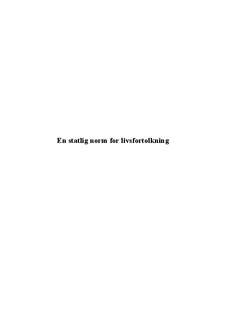| dc.description.abstract | In this study, the process leading up to the adoption of the Norwegian Same-sex marriage laws is taken as an example of how normativity is institutionalized in a field related to the religious dimensions of life, in a pluralized society.
A comparative analysis of interpretations of the personal identity and the norm for the primary human affiliation in three categories of documents is performed, based on Robert Cumming Neville’s hypothesis of theology as symbolic engagement. These documents are (1) The UN Convention of the Rights of the Child and Norwegian family laws, (2) the governmental hearing document proposing changes in Norwegian marriage- and family laws, including enclosed reports, and (3) hearing statements from three consultative bodies affiliated to Christian traditions.
The study sheds light on the degree to which post-colonial criticisms of power at play and universalism are taken into consideration in the legislative process. Three theses are discussed and supported by the findings of the analysis:
- The hearing document proposing the Same-sex marriage laws presupposes that religious symbols, understood as interpretations constructing the world, are renegotiated.
- Through their statements, hearing bodies affiliated to Christian traditions are giving relevant observations, and backing up their critical comments with general and not dogmatic arguments.
- Through the proposal, symbols from one agent’s philosophy of life are institutionalized as normative for the many different philosophies of life, which the inhabitants of a pluralist society engage to orient and transform their lives.
The study discloses that, through the proposal, homosexual orientation is inserted as an alternative interpretation of personal identity, and engaged as an orienting symbol for marriage and family law. Rather than following the Convention of the Rights of the Child in including human affiliations in its interpretation of personal identity, the government engages an interpretation, which ignores such affiliations. The consequences are that the conceptual framework engaged does not facilitate a much needed discussion about the consequence the reform has on the rights of the child, and the way in which Norwegian laws attend to the child’s best interest. The proposal neither clarifies the relationship between the two different interpretations of personal identity within the legislation, nor the consequences of introducing different rights based on different interpretations of personal identity into the legislation.
By analyzing interpretations of the norm for the primary human affiliation, it is found that the proposal renegotiated this symbol. Biological origin, which has been taken to unconditionally constitute parenthood in UN conventions and Norwegian legislation, is made conditional through the proposal. A new symbol of the primary human affiliation is not accounted for, but intention is introduced as a constituting criterion alone and in combination with biological origin. In sum it is found that the proposal introduces inconsistencies into the legislation both with regards to equal rights between children, between women married to women and women married to men, between female married couples and male married couples, and between married and single women. These inconsistencies are not explained and clarified in the process.
The hearing bodies did offer comments and objections to the proposal. These were hardly taken into consideration, and it is found that arguments were declined on the basis of the agents’ identities. The hearing statements included considerations about the ambition of the initiative. The reform was introduced as a measure to prevent discrimination and secure the human rights of lesbians and gays. Hence, the hearing document finds that the protection of the human rights of lesbians and gays through Norwegian legislation exceeds the demand of the UN conventions. It is found that the proposal disclosed an ambition to introduce a governmental norm for the inhabitants’, religious communities, and philosophies of lives’ interpretations of life, justified as a step against prejudice. Furthermore, the initiative is characterized by an international ambition of human rights development, to oppose discrimination and prejudice in the legislation and praxis of other countries.
It is clear from the analysis that to the degree that post-colonial criticisms of power at play and universalism are taken into consideration in the legislative process, the hearing bodies affiliated to Christian traditions raised these considerations. Their arguments are not attended to and the Same-sex marriage laws repeats the practice of making one agent’s doctrine the norm for all inhabitants’ interpretations of what is good, true and just in a pluralist society. | no_NO |
